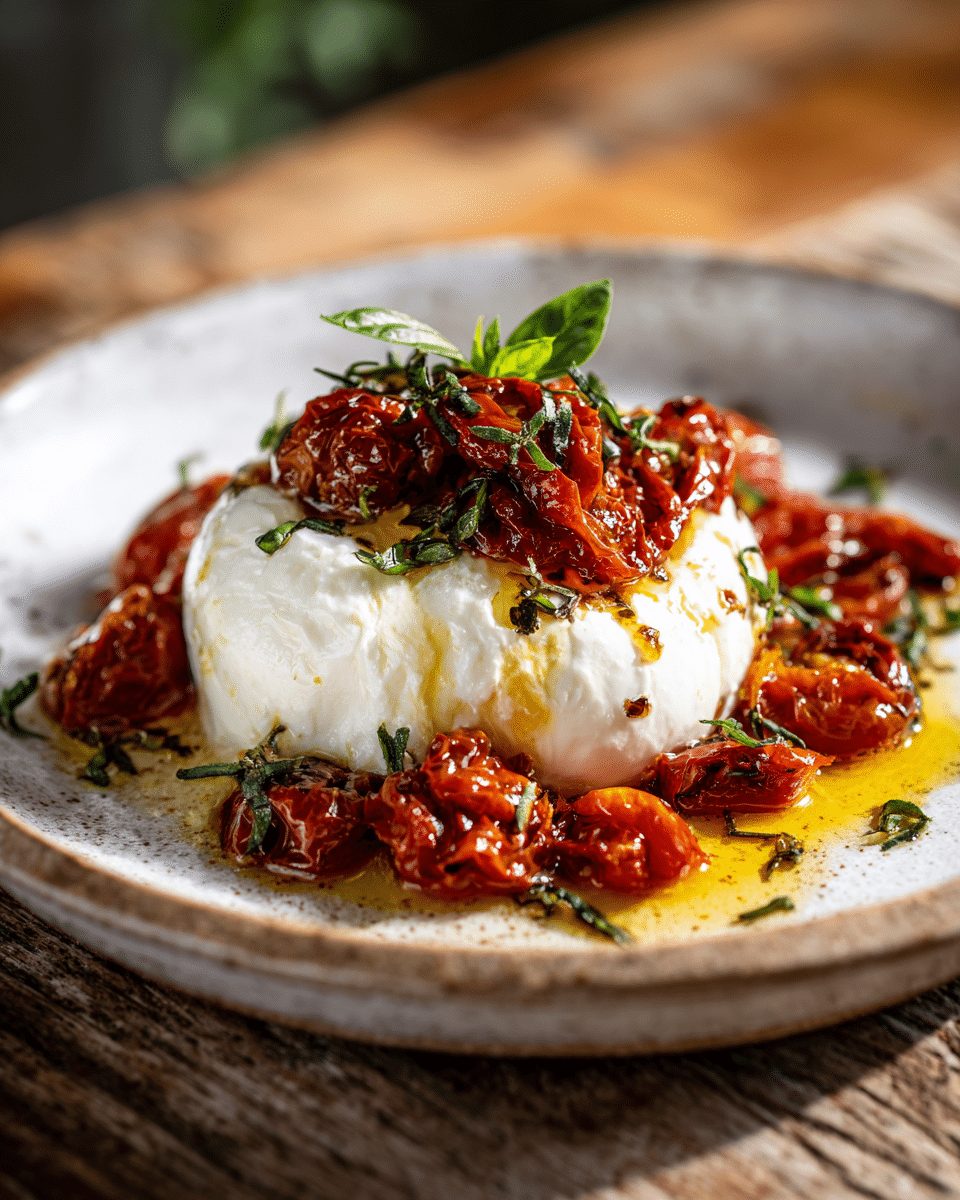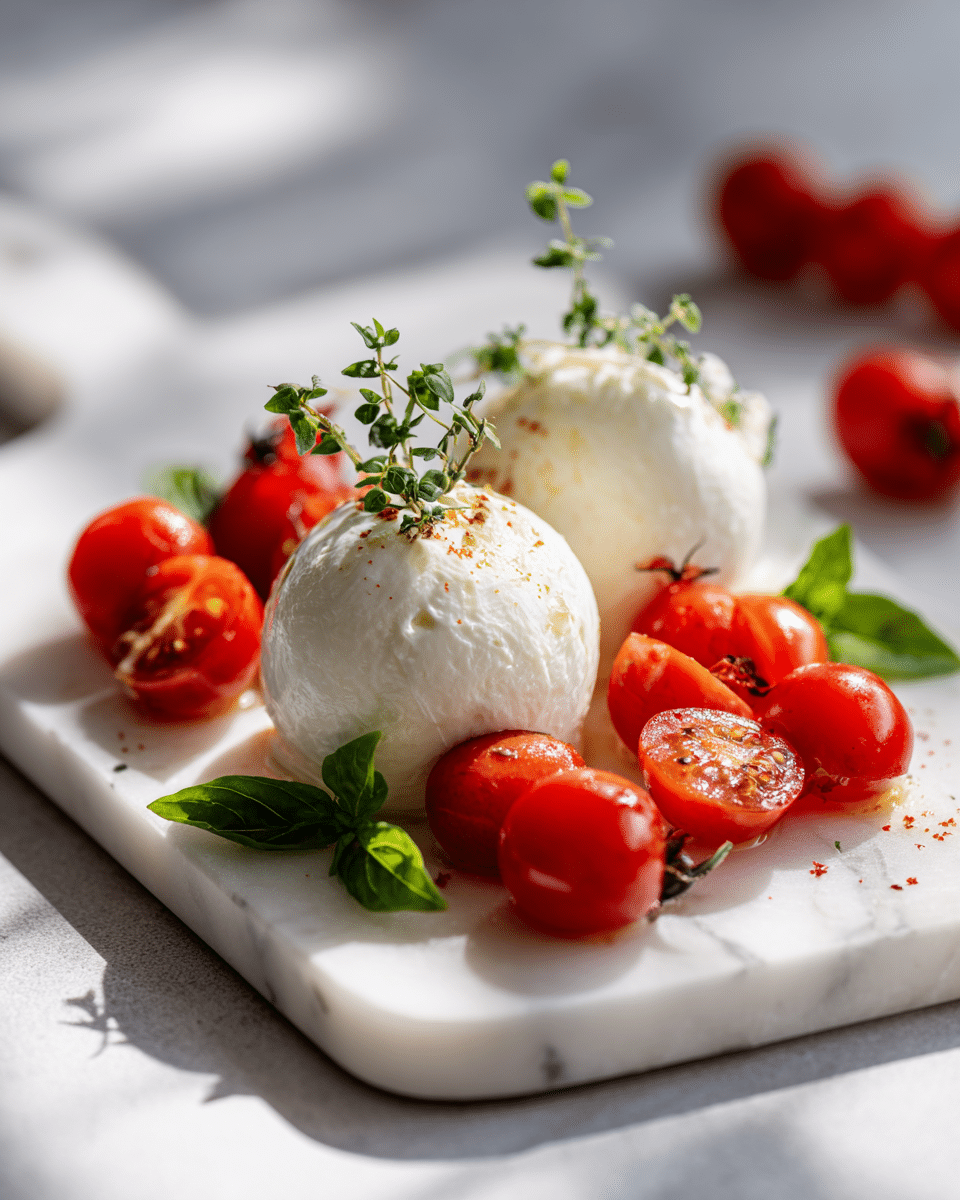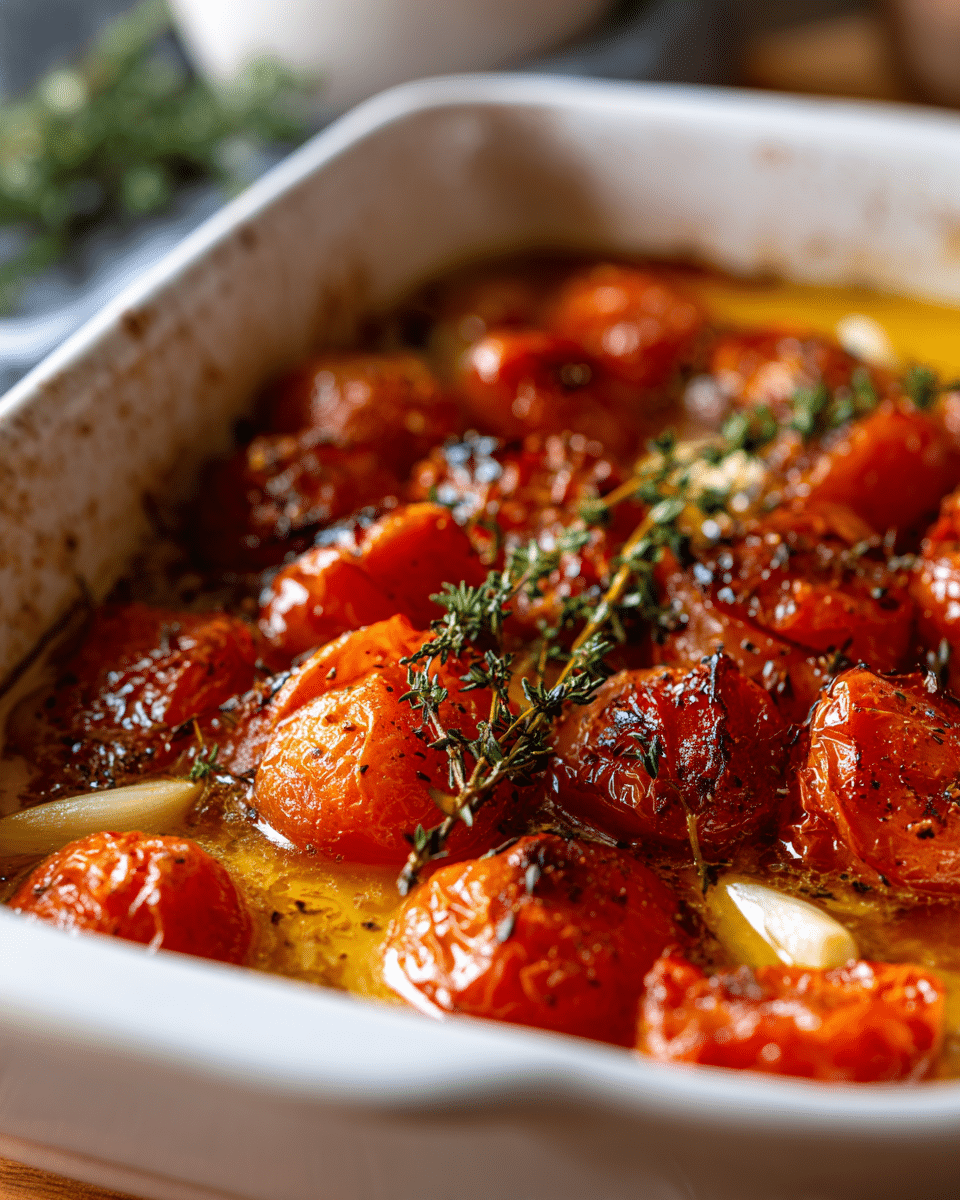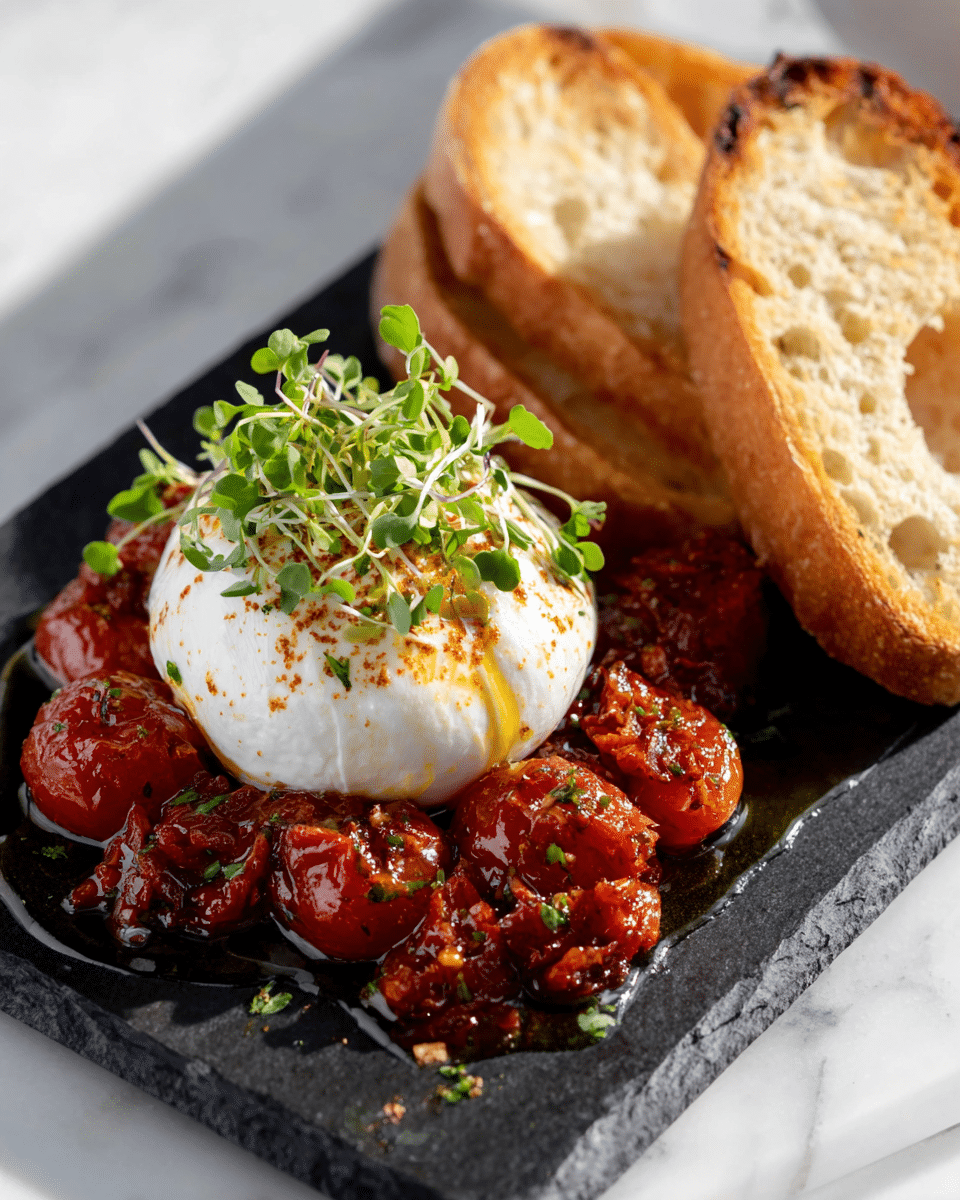
Table of Contents
Burrata with tomato confit is more than just a pretty plate—it’s a celebration of textures and flavors that bring the Italian countryside straight to your table. Imagine cutting into a silky ball of burrata, letting its creamy center flow over sweet, slow-cooked tomatoes, all drizzled with golden olive oil. This dish is simple yet luxurious, perfect for impressing guests or indulging in a personal treat. Whether served as a starter, on fresh bread, or alongside a crisp salad, it’s a flavor combination that never disappoints.
Understanding Burrata with Tomato Confit
What is Burrata Cheese and How Is It Made
Burrata is a fresh Italian cheese made from mozzarella and cream. The outer shell is solid mozzarella, while the inside contains stracciatella—soft shredded cheese mixed with rich cream. This creates a delicate pouch that bursts with velvety texture when sliced. Originating in Puglia, Italy, burrata is cherished for its mild, milky sweetness and buttery finish. Unlike regular mozzarella, burrata offers a creamier mouthfeel, making it a star ingredient in elegant appetizers and salads.
The Origin and Flavor Profile of Tomato Confit
Tomato confit is a French-inspired cooking method where tomatoes are slowly roasted or simmered in olive oil, often with garlic, fresh herbs, and a pinch of salt. This slow, gentle cooking intensifies their natural sweetness and adds a rich, jam-like consistency. Using cherry or grape tomatoes is ideal because their size and natural sugar content create a concentrated flavor. In Mediterranean cuisine, tomato confit adds depth to pasta dishes, toast toppings, and even grilled meats—making it a perfect partner for the creamy subtlety of burrata.
The Perfect Flavor Marriage
Why Burrata and Tomato Confit Complement Each Other
Pairing burrata with tomato confit is like putting sunshine and clouds on the same plate—one bright and tangy, the other soft and mellow. The creamy richness of burrata tones down the concentrated sweetness of tomato confit, while the confit’s olive oil infusion adds a silky layer that echoes the cheese’s texture. Together, they create a balance of sweet, savory, and umami notes that feels indulgent yet light.
Balancing Creamy, Savory, and Sweet Notes in Dishes
The secret to a successful burrata with tomato confit dish is balance. A sprinkle of flaky sea salt heightens the sweetness of the tomatoes, while fresh herbs like basil or thyme add freshness to cut through the creaminess. For a touch of crunch, add toasted bread or crostini—it creates contrast and makes each bite more satisfying. If you’re exploring other sweet-and-savory cheese pairings, check out burrata with roasted plums, pistachios, and thyme for another seasonal twist.
Ingredients You Need for Burrata with Tomato Confit
Choosing Fresh, High-Quality Burrata Cheese
The star of this dish is burrata, so it’s worth sourcing the freshest you can find. Look for burrata with a smooth, glossy outer layer and a soft, full pouch inside. Ideally, it should be made from cow’s milk for a rich, buttery flavor, though buffalo milk burrata offers a tangier profile. If you want to see how burrata shines in other refreshing pairings, try this burrata with cantaloupe recipe for a sweet summer option.

Selecting the Right Tomatoes and Herbs for Confit
For tomato confit, cherry or grape tomatoes work best due to their natural sweetness and small size. Choose tomatoes that are firm yet ripe, ensuring they hold shape during slow cooking. Fresh herbs—especially thyme, rosemary, or basil—infuse the olive oil with aromatic depth, while garlic adds a subtle punch. Always use a high-quality extra virgin olive oil since it becomes a central flavor in the dish.
How to Make Tomato Confit at Home
Step-by-Step Tomato Confit Preparation
Making tomato confit is a slow but simple process:
- Preheat the oven to around 250°F (120°C) for gentle roasting.
- Prepare the tomatoes by washing and drying them. Keep them whole if small, or halve larger ones.
- Arrange in a baking dish and add whole garlic cloves, fresh thyme, and rosemary sprigs.
- Generously coat with olive oil—enough to cover the tomatoes halfway.
- Season lightly with sea salt and freshly ground pepper.
- Bake slowly for 1½ to 2 hours until tomatoes wrinkle slightly but remain juicy.
The slow roasting caramelizes their sugars, producing a deep, concentrated flavor.

Tips for Achieving the Perfect Texture and Flavor
- Don’t rush the process—high heat will dry out or scorch the tomatoes.
- Use a neutral baking dish like ceramic or glass to prevent metallic flavor transfer.
- Infuse extra oil with chili flakes if you want a gentle kick.
- Save the infused olive oil for drizzling over salads, bread, or grilled vegetables—it’s liquid gold.
For a different cheesy baked option, explore our swicy baked feta recipe, which also uses slow roasting for maximum flavor.
Assembling the Perfect Burrata with Tomato Confit Plate
Plating Techniques for Visual Appeal
Presentation plays a big role in elevating burrata with tomato confit from a casual snack to a restaurant-worthy appetizer. Start by placing the burrata slightly off-center on a flat serving plate or shallow bowl. Spoon the tomato confit and its aromatic oil around and partly over the cheese, allowing the juices to mingle. Scatter fresh basil leaves for color contrast and brightness. For added sophistication, drizzle a few drops of aged balsamic vinegar in a loose swirl pattern across the plate.
Enhancing Flavors with Seasoning and Garnishes
A light sprinkle of flaky sea salt right before serving wakes up the creamy richness of the burrata. Freshly cracked black pepper adds a gentle heat, while microgreens lend both beauty and freshness. If you prefer more crunch, top with toasted pine nuts or crushed pistachios for a nutty counterpoint to the soft textures. For guests who enjoy bread, serve with warm crostini or sourdough slices—perfect for soaking up the confit’s infused olive oil.

Assembling the Perfect Burrata with Tomato Confit Plate
Plating Techniques for Visual Appeal
Presentation plays a big role in elevating burrata with tomato confit from a casual snack to a restaurant-worthy appetizer. Start by placing the burrata slightly off-center on a flat serving plate or shallow bowl. Spoon the tomato confit and its aromatic oil around and partly over the cheese, allowing the juices to mingle. Scatter fresh basil leaves for color contrast and brightness. For added sophistication, drizzle a few drops of aged balsamic vinegar in a loose swirl pattern across the plate.
Enhancing Flavors with Seasoning and Garnishes
A light sprinkle of flaky sea salt right before serving wakes up the creamy richness of the burrata. Freshly cracked black pepper adds a gentle heat, while microgreens lend both beauty and freshness. If you prefer more crunch, top with toasted pine nuts or crushed pistachios for a nutty counterpoint to the soft textures. For guests who enjoy bread, serve with warm crostini or sourdough slices—perfect for soaking up the confit’s infused olive oil.
Print
Burrata with Tomato Confit – A Decadent Italian Delight
- Total Time: 2 hours 15 minutes
- Yield: 4 servings
- Diet: Vegetarian
Description
Burrata with tomato confit blends creamy Italian cheese with sweet, slow-cooked tomatoes for a simple gourmet dish.
Ingredients
1 ball fresh burrata cheese
2 cups cherry tomatoes
1/2 cup extra virgin olive oil
3 garlic cloves
Fresh thyme sprigs
Salt and pepper to taste
Instructions
1. Preheat oven to 250°F (120°C).
2. Wash and dry tomatoes. Place in baking dish with garlic and thyme.
3. Cover with olive oil. Season with salt and pepper.
4. Bake for 1½–2 hours until tomatoes wrinkle slightly.
5. Plate burrata and spoon tomato confit around it.
6. Garnish with basil leaves and drizzle with extra oil.
Notes
Serve immediately for best flavor.
Tomato confit can be refrigerated in olive oil for up to 2 weeks.
Bring burrata to room temperature before serving for optimal creaminess.
- Prep Time: 15 minutes
- Cook Time: 2 hours
- Category: Appetizer
- Method: Baking
- Cuisine: Italian
Wine and Beverage Pairings for Burrata with Tomato Confit
Best Wines to Complement Creamy and Tangy Flavors
When pairing wine with burrata and tomato confit, you want a bottle that complements without overpowering. A crisp Sauvignon Blanc or Pinot Grigio works beautifully—the acidity balances the richness of the cheese while enhancing the tomato’s natural sweetness. For red wine lovers, a light-bodied Pinot Noir with subtle berry notes pairs surprisingly well, offering a gentle contrast to the creaminess.
Non-Alcoholic Options for a Refreshing Balance
If you prefer alcohol-free pairings, try sparkling water with a slice of lemon or a lightly brewed iced tea infused with herbs like mint or basil. These beverages cleanse the palate between bites and keep the flavors fresh. For a fruit-forward option, a chilled hibiscus tea adds a floral tartness that pairs perfectly with the dish—much like the fruity elegance found in our goat cheese crème brûlée pairing ideas.
Storage and Make-Ahead Tips
How to Store Tomato Confit Without Losing Flavor
Tomato confit stores beautifully when handled properly. Transfer the cooled tomatoes and their infused oil to a sterilized glass jar, making sure the tomatoes are fully submerged in oil to prevent spoilage. Store in the refrigerator for up to two weeks. The oil will solidify slightly when chilled—just bring it to room temperature before serving to restore its silky texture. For longer storage, freeze the confit in airtight containers for up to three months.
Keeping Burrata Fresh for Optimal Taste
Burrata is best enjoyed fresh, ideally within 24–48 hours of purchase. Keep it in its original packaging or store it in a sealed container filled with its whey or lightly salted water to maintain moisture. Always keep it refrigerated and bring to room temperature for 20–30 minutes before serving to enhance its creamy texture and flavor. Avoid freezing burrata—it alters the delicate consistency and taste.
Health Benefits and Nutritional Profile
Nutritional Breakdown of Burrata Cheese and Tomato Confit
Burrata is indulgent, but it also offers nutritional perks. It’s a good source of protein and calcium, supporting muscle health and bone strength. However, it’s also high in saturated fat and calories, so portion control is key. Tomato confit, on the other hand, is rich in antioxidants—especially lycopene—thanks to the slow-cooking process that enhances nutrient availability. The olive oil used in confit is a heart-healthy fat, contributing beneficial monounsaturated fats to your diet.
Moderation Tips for Enjoying Indulgent Dishes
To enjoy burrata with tomato confit without overdoing it, consider serving smaller portions as part of a larger meal. Pair with plenty of fresh greens or whole-grain bread to boost fiber content and make the dish more filling. You can also opt for low-fat burrata alternatives or use less olive oil in the confit if you’re watching your calorie intake. This way, you can savor every bite while keeping your meal balanced.
What is burrata and tomato confit?
Burrata and tomato confit is a dish that pairs creamy Italian burrata cheese with slow-cooked, olive-oil–infused tomatoes. The combination balances rich, milky flavors with sweet, tangy notes for a simple yet gourmet appetizer or side dish
What pairs well with tomato confit?
Tomato confit pairs beautifully with cheeses like burrata, mozzarella, or goat cheese. It also works well as a topping for pasta, grilled fish, roasted meats, or spread over toasted bread for a rustic snack.
What can I do with tomato confit?
Tomato confit can be served on crostini, tossed with pasta, layered into salads, or spooned over grilled vegetables. The infused oil can be used as a flavorful drizzle for soups, roasted potatoes, or fresh greens.
What is burrata best paired with?
Burrata shines when paired with fresh tomatoes, fruit like peaches or figs, roasted vegetables, or prosciutto. It’s also delicious with crusty bread, a drizzle of olive oil, and a sprinkle of sea salt for a minimalist approach.
Conclusion
Burrata with tomato confit is proof that the best dishes often come from the simplest ingredients. The lush creaminess of burrata paired with the rich sweetness of slow-cooked tomatoes creates a flavor harmony that feels both comforting and refined. Whether you serve it as an appetizer, a light main course, or a shareable centerpiece at your next gathering, this combination will leave a lasting impression. And with the right plating, pairings, and storage tips, you can enjoy it any time of year—making it a timeless addition to your culinary repertoire.
Craving more edible art? Follow my culinary adventures on Facebook and save your next masterpiece on Pinterest!
